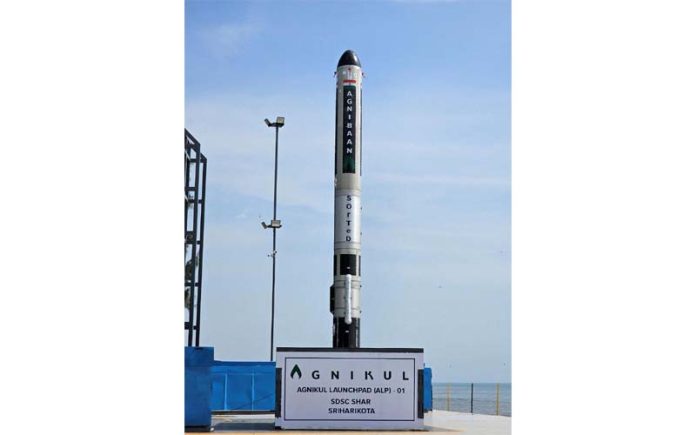NEW DELHI, May 28 : Chennai-based space start-up Agnikul Cosmos on Tuesday called off the maiden launch of its 3D-printed, semi-cryogenic Agnibaan rocket yet again due to technical glitches detected seconds before lift-off.
The IIT-Chennai incubated start-up made two renewed attempts at launch from its own launch pad at Sriharikota — first around 5.30 am and another at 9.25 am — which had to be put on hold due to problems in the Hold Down Release Mechanism (HDRM) and igniter failure, respectively.
The second attempt on Tuesday was put on “temporary hold to check igniter performance” just five seconds before lift-off.
This was the fourth attempt by Agnikul to launch the Agnibaan Sub-Orbital Technology Demonstrator (SOrTeD) since March 22, when the test flight was first scheduled to be held at the Agnikul Launch Pad at ISRO’s Satish Dhawan Space Centre at Sriharikota.
The start-up made the second attempt to launch the rocket on April 6, which was called off during the pre-launch checks. The third attempt was made on April 7, which had to be called off within a second of the commencement of the automated launch sequence due to communication issues with the onboard software.
Agnikul is seeking to conduct India’s second private rocket launch, following start-up Skyroot Aerospace’s November 2022 launch of the Vikram-S sub-orbital rocket in its maiden attempt.
Agnibaan is a customisable, two-stage launch vehicle that can carry a payload of up to 300 kg into orbit of about 700 km, according to the company.
The rocket uses a semi-cryogenic engine with a mix of liquid and gas propellants, a technology that is yet to be demonstrated by the Indian Space Research Organisation (ISRO) in any of its rockets.
The SOrTeD mission is a single-stage launch vehicle demonstration that will be powered by a semi-cryogenic engine, the Agnilet, a sub-cooled liquid oxygen-based propulsion system developed indigenously.
The start-up has readied the vehicle with the first-ever ethernet-based avionics architecture and fully in-house developed autopilot software from India.
Powered by sub-cooled Liquid Oxygen (LOX) and Aviation Turbine Fuel (ATF), the vehicle is equipped with four carbon composite fins to provide passive control.
The Agnilet engine is the world’s first single-piece 3D-printed semi-cryogenic rocket engine.
The mission will last just over two minutes from launch to splashdown.
Following lift-off, the vehicle is expected to perform a pitch-over manoeuvre nearly four seconds into flight.
This manoeuvre involves the controlled rotation of the vehicle to change its orientation from vertical to a predetermined angle with respect to the ground or its flight path.
The vehicle will then go into the wind-biasing manoeuvre at just over 39 seconds, which is introduced in rockets to compensate for the effects of wind on the trajectory of the rocket during ascent.
At 1 minute 29 seconds, the launch vehicle is expected to reach apogee, the point it will be farthest from the launch site before it splashes down at just over two minutes into the flight, marking the completion of the mission. (PTI)


